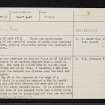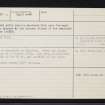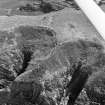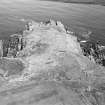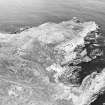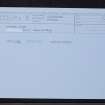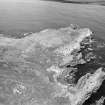Crathie Point
Promontory Fort (Iron Age)
Site Name Crathie Point
Classification Promontory Fort (Iron Age)
Canmore ID 17947
Site Number NJ56NW 14
NGR NJ 5483 6717
Datum OSGB36 - NGR
Permalink http://canmore.org.uk/site/17947
- Council Aberdeenshire
- Parish Fordyce
- Former Region Grampian
- Former District Banff And Buchan
- Former County Banffshire
NJ56NW 14 5483 6717.
(Area NJ 5480 6717) There are earth-works consisting of two parallel mounds of earth with trenches on both sides, passing completely across the headland at Crathie Point.
Anon 1896.
Across the headland at Crathie Point at NJ 5483 6719 are the remains of an earthen rampart with a ditch on either side. The bank is c.6.0m wide by c.1.5m high and the ditches are c3.0m wide. A causeway c.5.0m wide leads through the rampart and ditches near the east end of the rampart. Some 90m SW of the rampart at the edge of a cultivated field is a similar rampart c.45m in length. There is a gap c.7m wide between the west end of the rampart and the steep natural slope. It is probable that on the south side of the rampart there was a ditch which has now silted up due to ploughing; and that use was made of a natural gully running eastward from near the east end of the rampart to the natural slopes of the headland.
Surveyed at 1:2500.
Visited by OS (WDJ) 19 September 1960.
Promontory Fort.
RCAHMS 1963.
Fort as described by Johnston (1960). There are slight indications of a further ditch, 0.2m deep, discernible immediately to the SW of, and parallel to the inner rampart.
Revised at 1/2500.
Visited by OS (NKB) 25 July 1967.
Air photographs: AAS/94/06/G15/12-14.
NMRS, MS/712/21.
NJ 5483 6717 We visited the site with a view to carrying out a topographic survey of the current condition of the promontory fort. The main features still visible consist of an outer bank 7.5m wide and 0.3m high crossing the promontory, extending to some 50m with a less well defined bank extending for another 10m. Some 50m behind the outer bank an inner bank crosses the promontory with a ditch to the front and rear. The inner bank was 7.5m wide and 1.5m above ground surface to the N and 0.5m above ground to the S. The southern ditch was about 0.75m in depth and the northern ditch was 0.2m in depth. Between the two banks there is a pond that appears to be artificial. The total width of the promontory was c 120m. In the area not protected by the outer bank a natural gully appears to have been enhanced to help defend the site. No other remains were noted. The promontory runs broadly N-S. Recent agricultural operations have removed the western end of the outer bank and the exposed cross section shows that it is made of soil and stones.
Plans lodged with RCAHMS, Aberdeenshire Archaeology Service and NMS.
David Irving, David Anderson, Ken Cooper and Alex Bruggimann, 2006.
Reference (1963)
This site is noted in the ‘List of monuments discovered during the survey of marginal land (1956-8)’, published in Vol. 1 of the RCAHMS Inventory of Stirlingshire. The 26 monuments were listed by their name, classification, parish and county, and the list also includes an indication of whether they had been planned (P), whether they were visible only as a cropmark (C), and whether they were worthy of preservation (*).
Information from RCAHMS (GFG) 30 October 2012.
Excavation (May 2014)
NJ 5483 6717 As part of the Northern Picts Project surveys and excavations have been undertaken in an area stretching from Aberdeenshire to Easter Ross targeting sites that can help contextualize the character of society in the early medieval period in northern Pictland.
In May 2014 two forts near the site of the Gaulcross Pictish hoard were targeted to provide dating for the nearest fortified sites to the hoard site. The 1960 OS assessment of the site recorded two earthen ramparts cutting off the promontory with ditches on either side of the inner rampart and an entrance causeway around 5m wide. In 2006 a plane table survey was conducted which recorded the two ramparts and an artificial ‘pond’ between the two ramparts.
The 2014 work included the excavation of trenches across the ditches on both sides of the inner rampart. Only the upper deposits were excavated due to the incredibly tenacious nature of the clay geology on the peninsula. In the inner ditch fill a charcoal horizon was found in upper fills, charred material from the ditch was dated to the Early Iron Age (Beta-381814
2550 +/- 30 BP; 785–535 cal BC 95.4%). A further trench close to the outer ditch of the inner rampart contained a posthole and narrow slot, the probable remains of a palisade. The ‘pond’ proved to be a modern feature (under the bank pieces of concrete and glass were identified). The finds suggest that the pond was dug sometime during the 20th century. A series
of smaller test pits were also excavated on the promontory. No archaeological features or deposits were found in these test pits.
Archive: University of Aberdeen
Funder: University of Aberdeen Development Trust in partnership with the Tarbat Discovery Centre
Gordon Noble and Oskar G Sveinbjarnarson – University of Aberdeen
(Source: DES)
Note (16 April 2015 - 4 November 2016)
Crathie Point, the large headland due E of Findlater Castle, is cut off on the SSW, landward, side by two lines of ramparts and ditches. The inner cuts off an area measuring 170m from NNE to SSW by a maximum of 90m transversely (1.25ha), though this includes the flanks of the promontory sloping down to the cliff-edge; the more easily occupied summit area is in the order of 0.47ha. The outer encloses a much bigger area measuring 230m in overall length by up to 135m in breadth (1.8ha), though again the more level summit area is rather less, probably extending to about 1.12ha. The inner or northern rampart is up to 7.5m in thickness, by 0.5m in height externally and 1.5m internally, and is flanked to either side by ditches about 3m in breadth. The outer line, which lies at the edge of the cultivated field 50m to the S, is also some 7.5m in thickness but only 0.3m in height and was probably accompanied by a ditch on its S; this rampart can be traced for a distance of about 50m across the promontory from the W, the line of its probable ditch being carried on eastwards from the corner of the field by a natural gully. A gap between the cliff-edge on the W and the end of the rampart probably marks the position of an entrance, while a causeway across the ditches at the E end of the inner defences also marks an original entrance. There is no evidence to indicate whether the two lines of defences are contemporary.
Information from An Atlas of Hillforts of Great Britain and Ireland – 04 November 2016. Atlas of Hillforts SC2957












